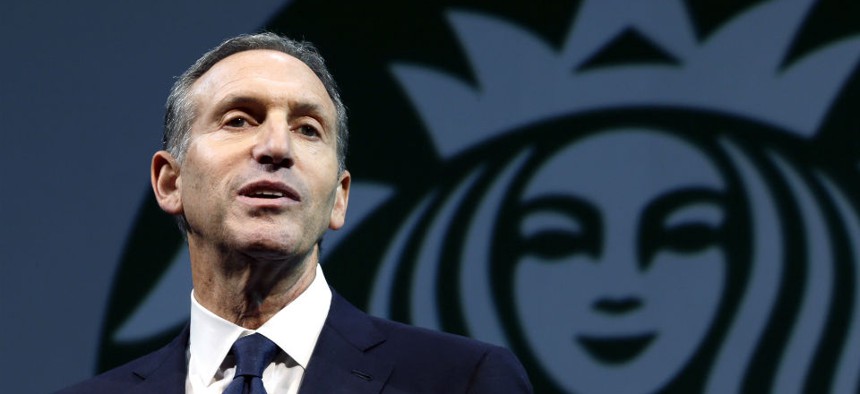
Starbucks CEO Howard Schultz is working to bridge the military-civilian divide. Ted S. Warren/AP
Unemployment Among Post-9/11 Vets Is Still High
But efforts by the government and the private sector to hire former service members are making a difference, data shows.
The unemployment rate among post-9/11 veterans remains higher than that of other vets and the country overall, despite large-scale efforts by the government and private sector to hire more former service members.
The jobless rate among Gulf War-Era II vets, as the Bureau of Labor Statistics classifies them, was at 7.2 percent in October, compared to the country’s overall 5.8 percent unemployment and a 4.5 percent unemployment rate among all vets over the age of 18. The employment situation for post 9/11 vets is even more alarming when you look at the numbers by gender: The BLS reported an 11.2 percent unemployment rate for female vets in October, compared to a 6.2 rate for male vets. Since the 2001 terrorist attacks, roughly 2.8 million men and women have served in the military.
And yet, other statistics show a more promising picture of efforts by the public and private sectors to hire more veterans, particularly those who fought in Iraq and Afghanistan. The nonprofit research RAND Corporation, at the request of JPMorgan Chase and Co., just released a report on the 100,000 Jobs Mission, an initiative launched in 2011 by eleven companies to hire 100,000 vets by 2020. Now, three years into the initiative, there are 176 participating companies that have hired a total of 190,046 veterans. The businesses include a range of firms in different sectors, such as JPMorgan, AT&T, Cushman and Wakefield and Universal Health Services, Inc.
“Coalition companies identified great value in veteran employees,” said the RAND study, which interviewed 26 companies participating in the vets’ hiring initiative. “Leadership skills and teamwork were cited most frequently as valuable veteran qualities.”
In the federal government, President Obama’s 2009 executive order directing federal agencies to hire more veterans has increased the number of vets working in government by 5 percent between 2009 and 2014. In fiscal 2013, vets accounted for 30.1 percent of the total federal workforce, according to the Office of Personnel Management.
But numbers only tell one side of the story. One of the biggest challenges when it comes to hiring veterans, according to the RAND study, is matching service members’ skills with civilian job requirements. Employers’ education requirements don’t always align with a vet’s level of education, and entry-level jobs with low pay aren’t necessarily attractive to a former service member who has had leadership roles in the military.
That disconnect is a microcosm of the large-scale chasm between military and civilian communities in America today—an issue most recently explored in a new book, “For Love of Country: What Our Veterans Can Teach Us About Citizenship, Heroism and Sacrifice,” by Washington Post journalist Rajiv Chandrasekaran and Starbucks Chief Executive Officer Howard Schultz. The two men also put together Tuesday’s free Veterans Day Concert for Valor on the National Mall, expected to draw 800,000 people and featuring a long line-up of A-list entertainers.
Post- 9/11 vets don’t experience the kind of criticism when they return from war, like some Vietnam vets did, Chandrasekaran and Schultz said during a discussion Monday at the Post about the book and the post-war contribution of vets. But the men and women who served in Iraq and Afghanistan still feel profoundly isolated from a country that reveres them, though often does not appreciate their experiences and sacrifices or the hardships on their families. Many Americans do not have family members or friends who have served in the military, so the image of a vet ridden with post-traumatic stress disorder unable to transition successfully into civilian life can dominate their views. “It would be wrong to look at all of our veterans as broken, as ticking time-bombs,” said Chandrasekaran.
The RAND study concluded that some of the fears that employers expressed about hiring “violent” vets in a 2012 study from the Center for New American Security may have dissipated, as more employers relate positive experiences with their veteran hires.
“When asked directly about veteran risks or downsides, some companies volunteered that PTSD was not an issue for veteran employees, even though interviewers did not ask specifically about PTSD,” the RAND study said. “Concerns about PTSD were not salient for most of our interviewees; they did not raise the issue. It is important to note that this finding contrasts with that of an earlier study of veteran employment, in which more than one-half of the companies interviewed reported concerns about negative stereotypes of veterans and PTSD. This may suggest that employers' initial concerns have been allayed by their experiences.”
Employers need to bridge the gap of “trepidation and anxiety” that many vets feel when it comes to finding a civilian job, Schultz said. “Rajiv and I heard an enlisted person tell us that they had more anxiety going to a job interview than they did going back to Afghanistan.”
Schultz, as someone who had “no military exposure” until he visited West Point in New York three years ago, is doing his best to shrink the military-civilian divide. “That [West Point visit] started me on this emotional journey to recognize the extraordinary contribution that the military was making for our country.”
And there was also a personal connection: Schultz’s father was a World War II veteran stationed in the South Pacific. He came back to the United States with yellow and dengue fever and refused to speak about the war, Schultz said. “It was a subject that was just forbidden. I can only imagine what he experienced.”







